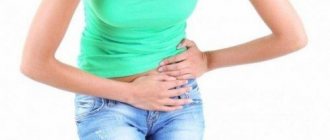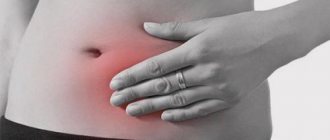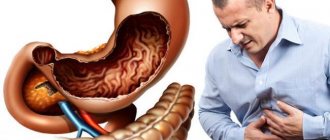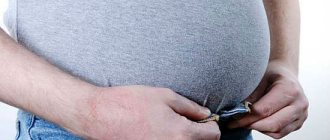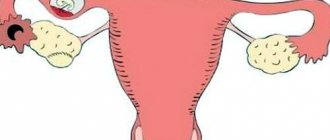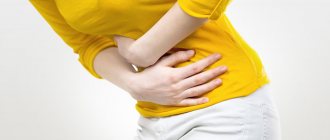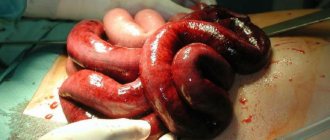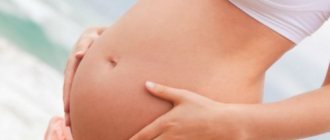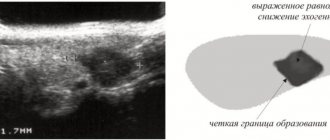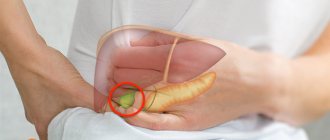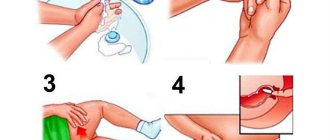Constant pain in the lower left abdomen may be a sign of an ectopic pregnancy
Pyelonephritis
When carrying a child, the organs of the urinary system experience increased stress: an increase in the volume of fluid circulating in the body forces them to work with double force. Thus, the kidneys become much more vulnerable to infections, and a serious disease can develop - pyelonephritis. The paired organs are localized in the lumbar region, on both sides of the spine, they are adjacent to the peritoneum, therefore, when the left kidney is inflamed, the pain can radiate, respectively, to the left side (namely its lower part).
Often pyelonephritis occurs against the background of cystitis, when the disease is left to chance or is not completely treated.
Pain in the left side can be caused by pyelonephritis
Appendicitis
Another condition that can potentially cause pain in the lower left side of the abdomen is appendicitis. The growing uterus puts pressure on the appendix and thereby provokes the development of the inflammatory process. And although the rudimentary appendix is located on the right, in acute illness pain in the left side cannot be ruled out.
Symptoms of appendicitis can be suspected by sharp stabbing pain, attacks of nausea and vomiting, and hyperthermia.
A pregnant woman, like any person, can develop appendicitis at any time.
Causes
The left side of the abdomen contains some organs that perform certain functions. Any discomfort during pregnancy should alert any woman and be a reason to contact her doctor.
There are three types of abdominal pain on the left side during pregnancy, which are not always associated with the period of gestation:
- physiological (do not require any treatment and go away on their own);
- pathological associated with pregnancy;
- pain from diseases not related to the process of embryo development.
In the early stages, pain most often occurs due to the growth of the uterus. This condition is not a pathology and does not pose any threat to mother and baby. During the implantation of the fertilized egg into the walls of the uterus, some women feel minor stabbing pains in the lower abdomen, which go away on their own no more than 24 hours after their onset.
After 13 weeks, the size of the uterus increases several times and it begins to extend beyond the pelvis. During this process, the ligaments that secure it also stretch and nagging pain from below, reminiscent of menstrual pain, may appear.
Unpleasant sensations can intensify with any physical activity and go away on their own with rest. This condition is also considered physiological and does not require therapeutic measures. Starting at 15 weeks, the uterus begins to gradually put pressure on nearby organs, in particular the ovaries, bladder and intestines.
Many women begin to complain that there is a sharp pain in the lower abdomen on the left or right, radiating to the perineum. But the discomfort disappears immediately after emptying the bladder or bowel. But there are other reasons that can affect the life of the baby and the expectant mother.
Risk of miscarriage
A pathological condition in which there is a high risk of spontaneous abortion. The cause of miscarriage may be:
- woman’s age (from 35 years and above the risk increases);
- a history of miscarriages, bad habits (smoking and drinking alcohol);
- taking non-hormonal anti-inflammatory drugs on the eve of conception;
- high body temperature;
- severe stress;
- abdominal injuries;
- hormonal changes;
- Rhesus conflict.
The main symptom of the threat is that the lower abdomen hurts and the nature of the pain is cramping. In addition, bloody or bloody discharge of varying intensity may appear from the woman’s genital tract. Treatment is carried out in a hospital setting under the supervision of a doctor.
Ectopic pregnancy
A complication of the gestation period, characterized by its development outside the uterine cavity. The danger is that due to the growth of the embryo, the walls of the fallopian tube are stretched, which is not intended for this. As a result, it cannot withstand the stress and bursts. As a result, internal bleeding opens, which can be followed by the death of the woman.
Treatment of ectopic pregnancy is only surgical, by excision of the ovum
There are several reasons why pathology occurs: anatomical changes in the structure of the reproductive organs, severe inflammation in the fallopian tubes, surgical operations on the eve of pregnancy (caesarean section, removal of uterine fibroids, etc.), frequent abortions, hormonal levels.
The clinical picture is as follows: a woman complains that there is pain in the left lower abdomen during pregnancy, but the pain can radiate to the left side if the embryo is on the left, and vice versa.
Hypertonicity of the uterus
Constant tension in the muscles of the uterus. The duration of this condition can vary from several hours to 1–2 days. Pain with hypertonicity is strong and irregular.
Most often, a woman feels discomfort in the lower abdomen or lower back, most often during early pregnancy, since the female reproductive organs are not fully formed, from a physiological point of view.
Training contractions
Contraction of the muscular layer of the uterus in an involuntary manner. When the lower abdomen begins to hurt on the left or right, many women, especially those who are pregnant for the first time, begin to panic and prepare to go to the maternity hospital. But how to distinguish training contractions from prenatal ones?
Prenatal symptoms tend to increase and become stronger each time, in addition, they have a certain rhythm. Training contractions last no more than 1 minute and can disappear without a trace.
Women with a low pain threshold experience considerable discomfort during involuntary and chaotic contractions of the uterus. In any case, you should see an obstetrician-gynecologist, since if measures are not taken in time, this may cause the onset of premature labor.
What not to do if you have pain
If abdominal pain occurs (single or periodic), a pregnant woman should be careful and take into account the following recommendations:
- pain of an incomprehensible nature cannot be “stifled” by taking analgesics (without the consent of the doctor);
- It is unacceptable to self-medicate, including folk remedies;
- It is forbidden to apply a heating pad to the stomach. Heat can only intensify the inflammatory process and provoke, for example, rupture of a cyst. In addition, it can cause bleeding and cause a miscarriage;
- If you have digestive problems, pregnant women should not have an enema: this can cause uterine tone and premature birth.
Pregnant women are prohibited from applying a heating pad to their stomach - this can increase inflammation and provoke a miscarriage.
Pain in the left side appears in an “interesting” position quite often. They are mainly physiological in nature. However, you must not let your guard down, because sometimes the cause of discomfort can be a serious pathology that requires emergency medical attention. In any case, it is always better to play it safe and report all your feelings to your doctor in a timely manner.
Higher philological education. Experience as a proofreader, editor, website maintenance, teaching experience (first category). Rate this article: Share with friends!
Non-gynecological reasons
Intestinal spasm, constipation, abnormalities in the functioning of the spleen, pancreas, left kidney or intestines, etc. are also reasons to consult a specialist. So why does the left side hurt during pregnancy, which is not associated with it? Most often, improper functioning of internal organs is associated with changes in a woman’s hormonal levels.
It is the pregnancy hormone, progesterone, that can influence the functioning of the gastrointestinal tract. And attacks of stabbing, cutting, pulling pain in the abdomen may become more frequent during this period. However, it should be understood that, as a rule, this condition is not pathological and goes away on its own over time.
Constipation
A pathological condition in which fecal retention occurs for 2 or more days. During pregnancy, every third woman faces the problem of constipation.
The cause of this condition may be:
- production of progesterone, which slows down intestinal motility;
- sedentary lifestyle;
- insufficient fluid intake;
- over a long period of time, compression of neighboring organs by the uterus occurs;
- some diseases of the gastrointestinal tract.
It is simply necessary to treat this condition, since feces, while in the intestines, over time begin to poison not only the woman’s body, but also the unborn baby. In addition, there is a high risk of premature birth, inflammation of the rectum and sigmoid colon, colitis and anal fissures.
Intestinal colic
Cramping pain caused by excessive swelling and tension of the muscles of the colon. Many women experience intestinal spasms during pregnancy. In almost every woman it appears during the implantation of a fertilized egg into the walls of the uterus. Some feel slight discomfort at this time, others do not experience anything.
Another cause of spasm may be rapid growth of the uterus, a stabbing sensation in the lower abdomen, or poor nutrition. To get rid of colic, you can take Espumisan or No-shpa, but only with the permission of your doctor.
As a preventive measure, it is necessary to adjust your diet, enriching it with vegetables and fruits, and arrange fasting days.
Pancreatitis
A disease caused by inflammation of the pancreas. Pancreatitis during pregnancy can occur due to: damage to the pancreas by viruses or bacteria, uncontrolled intake of certain vitamins, high standing of the uterine fundus, which compresses the bile ducts, peptic ulcer of the stomach and duodenum.
In the acute phase, pregnant women complain of intense girdle pain, nausea and vomiting, and stool upset. Often, women may develop other signs of the disease that are uncharacteristic for her: skin rash, allergic dermatitis, fungal infection of the vagina and vitamin deficiency. Treatment of pancreatitis is aimed at relieving pain, relieving inflammation and following a diet.
Spleen diseases
Injuries, cysts, inflammation, etc. are pathologies associated with a violation of the integrity of the organ. As a result of damage to the spleen, the following symptoms appear: severe pain in the left hypochondrium, cyanosis of the skin in the affected area, decreased blood pressure, rapid pulse, loss of consciousness due to severe pain.
In the case of the above symptoms, it is necessary to urgently seek help, since the pathology can harm not only the pregnant woman, but also the unborn child. The choice of therapy depends on the form and severity of the disease. In some situations, emergency surgery is indicated.
Gastritis
A disease caused by inflammation of the gastric mucosa. Exacerbation of gastritis during pregnancy can be caused by a number of factors: increased stress on the body of a pregnant woman, poor nutrition caused by early toxicosis.
The main cause of any inflammation in the stomach is the excessive proliferation of Helicobacter pylori. The main symptoms of the disease are pain in the left abdomen, mainly after eating, sour belching, and sometimes diarrhea, accompanied by pain along the intestines.
Treatment is carried out only under the supervision of a gastroenterologist with drugs approved for use by pregnant women.
Duodenitis
An inflammatory disease associated with damage to the duodenum. The reasons that cause irritation of the mucous membrane and its inflammation may be the following: food poisoning or intoxication of the body, foreign body, spicy, rough food, helminthiasis.
Pain in the intestines during pregnancy
At the onset of the disease, women lose their appetite, experience nausea and vomiting, and increased salivation. But it is very difficult to make a diagnosis based on these symptoms alone, because many people confuse them with early toxicosis.
Only after some time does dull pain begin to appear on the left side, body temperature rises slightly, and blood pressure drops. The disease can be diagnosed using duodenal intubation. Treatment should start with diet and a healthy lifestyle. It is also necessary to strictly follow all recommendations of the attending physician.
Treatment
Depending on the identified disease, the doctor will prescribe treatment for the expectant mother that is appropriate for her situation. For example, with pyelonephritis and many sexually transmitted infections, antibacterial therapy will be required. In case of exacerbation of gastritis, it is enough to follow an appropriate diet: a categorical refusal of spicy, fatty, fried foods, split meals.
For pancreatitis, it is recommended to take enzyme agents (Mezim, Creon, Festal, etc.), antacids (Almagel, Gaviscon) to reduce stomach acidity.
If pain is of a physiological nature, the pregnant woman’s condition can also be alleviated. For example, for constipation that occurs from compression of the intestines by the uterus, you can use laxatives and foods with a laxative effect: prunes, beets, pure vegetable oil before meals. In case of flatulence in the early stages, it is worth including more fresh vegetables and fruits and fermented milk products in the menu. Pain associated with uterine distension can be relieved by taking approved antispasmodics (for example, No-Shpy) with the obligatory agreement of the attending physician.
Diagnostics
During pregnancy, it is quite difficult to examine a woman. The maximum that is allowed by specialists is an ultrasound examination, and in difficult situations - a computed tomography or x-ray.
But usually, it is enough to collect an anamnesis (information about the time, nature and location of the localization), an examination by a gynecologist or surgeon, palpation of the abdomen, blood and urine tests in order to find out the diagnosis and begin gentle therapy, taking into account the characteristics of each woman and the duration of pregnancy.
The main thing to remember is that if any discomfort occurs, you should play it safe and consult a specialist for advice.
Signs and diagnosis of pain in the left side during pregnancy
Left abdominal pain during pregnancy varies in location and nature. Based on these signs, a preliminary diagnosis can be made. So, you need to listen and determine exactly how your left side hurts.
The pain may be:
- peritoneal – acute-piercing, aggravated by movement and turns of the body;
- visceral – having a “aching” character, sometimes cramping, most often occurring when the functions of the gastrointestinal tract are disrupted;
- unstable localization, “wandering”;
- radiating, manifesting itself in the area of healthy organs.
Short-term pain that is not periodic should not worry the expectant mother. Most likely they are associated with the growth and vital activity of the fetus.
But if they are constant, it hurts to sleep on your left side, the discomfort intensifies when walking, after eating, you need to undergo an examination to establish the cause of this condition.
How to alleviate a woman's condition
If your left side in the lower abdomen hurts during pregnancy, you can try following simple recommendations aimed at eliminating discomfort:
- stick to a diet. If you eat right, diversifying your diet with fruits and vegetables, you can normalize intestinal function and maintain its microflora. Sufficient water consumption ensures water balance in the body and prevents edema or dehydration. It is better to exclude confectionery and flour products, fats, hot seasonings, and coffee in large quantities from the diet. The more natural products a woman enters her body, the better she and her unborn child will feel;
- resort to moderate physical activity (walking, swimming, special gymnastics for pregnant women). It has long been known that all these activities are aimed at strengthening the muscles and ligaments in the pelvis. In addition, during walks or physical activities, blood flow improves, the placenta is enriched with oxygen, which has a positive effect on the health of the baby. It is worth noting that with the normal functioning of the placenta, it removes toxins and waste faster;
- minimize the number of negative situations and stress. Any negative emotions negatively affect the health of not only a pregnant woman, but any person. During the period of gestation, stress can lead to vasospasm and disruption of oxygen supply to the placenta; the tone of the uterus increases, due to which the expectant mother begins to experience pain in the left lower abdomen. Often discomfort appears on the right or near the navel.
Rest during pregnancy has a positive effect not only on the health of the mother, but also the baby.
Diagnosis for pain
When abdominal pain appears on the left, a pregnant woman should be very attentive to her condition and try to assess the nature of the discomfort. If these are physiological pain sensations during pregnancy, then they are usually short-term and not very pronounced. Otherwise, pathology should be suspected.
Some diseases can be recognized independently. For example, with gastritis (especially if it is chronic), discomfort will appear after eating, and the pain will be aching, accompanied by nausea and belching. Other pathologies can only be diagnosed by a doctor based on existing symptoms and additional examinations.
A pregnant woman must inform her gynecologist about any discomfort in the left side, describing in detail the accompanying symptoms. He will understand the situation and, if necessary, refer the woman for a consultation with a specialist: a surgeon or gastroenterologist. Further examination will be scheduled depending on the suspected diagnosis. For example, if you suspect pyelonephritis, you will need a urine test and an ultrasound of the kidneys. FGDS (fibrogastroduodenoscopy of the stomach) can confirm or exclude the presence of gastritis. In case of pancreatitis, a blood test for diastase will be indicative (determines the level of a biological enzyme necessary for digesting food).
Depending on the expected diagnosis, doctors prescribe additional examinations for the pregnant woman.
What you can and cannot do during abdominal pain
In order not to harm herself and her baby, every woman who becomes pregnant should remember what can and cannot be done for pain on any side of a different nature. You can do:
- Taking antispasmodics that relieve muscle tone of internal organs (allowed for intestinal spasms).
- You should lie down in bed and relax.
- Repeat taking antispasmodics at least 60 minutes after the last dose if the desired effect is not achieved.
You can't do:
- Apply a warm heating pad to your stomach (it can cause bleeding).
- Take painkillers and anti-inflammatory drugs (they blur the clinical picture of the disease).
- Take antibiotics, as they negatively affect the health of the mother herself and the unborn baby.
- Perform a cleansing enema or drink laxatives (if the cause of the pain is not constipation).
Remember! If the pain intensifies, do not hesitate and consult a specialist.
What organs are located on the left side of the abdomen?
The very state of the expectant mother’s body is what pain in the left side is often associated with. Due to the increased load on the organ system, “failures” are possible.
The causes of pain are often pathological in nature.
Most of the internal organs are located in the abdomen, including those on the left that may be of concern: the left-sided kidney, pancreas, spleen. In addition, it “gives” to the lateral region on the left due to inflammatory processes in the gastrointestinal tract, diaphragm, and also due to overstretching of the ligaments that hold the uterus.
All organs that signal a disorder of their functions through pain are necessary for the normal functioning of any person, and for the expectant mother their well-functioning work is doubly important.
The role of the kidneys in the life of the human body is invaluable. These paired organs, located in the lumbar region, act as filters and are directly involved in the functioning of the excretory system.
The kidneys are adjacent to the wall of the peritoneum, which is why pain is felt in the lower abdomen. An increase in the volume of circulating fluid in the mother's body forces them to work with redoubled force, which makes these organs vulnerable to infections.
Nonspecific inflammatory processes such as nephritis and pyelonephritis may worsen or occur for the first time, and renal failure may develop. If during pregnancy the left side of the lower abdomen hurts, and discomfort is felt in the lower back, it means that there may be a left-sided renal exacerbation.
Disturbances in the functioning of the spleen can also appear during pregnancy. This organ is located in the upper left part of the peritoneum, its purpose is to cleanse the blood of dead red blood cells and export them to the bone marrow, where new blood cells are formed.
Among the most common diseases of the spleen:
- her heart attack;
- twisting of the “leg”;
- abscess.
Chronic diseases of this organ lead to a general weakening of the immune system, which is very dangerous for both the mother and the fetus.
Quite often the stomach also makes itself felt with unpleasant symptoms. Heartburn and gastritis are frequent accompaniments of pregnancy, and a stomach ulcer can also form. Disturbances in the functioning of this digestive organ are a possible cause of pain in the left side during pregnancy. And this is largely explained by the connection between the stomach and the pancreas.
Pancreatitis is an inflammatory process in the pancreas, in which enzymes, instead of being transported to the duodenum, remain in the gland, undergoing self-digestion there. In this case, severe cutting pain on the left below the ribs may be disturbing. Uncontrollable vomiting with bile impurities often occurs.
The left side hurts during pregnancy and due to intestinal dysfunction. At first, it is provoked by the hormone progesterone, which relaxes the intestinal muscles and leads to frustration and a slowdown in the movement of food through it. Then the growing uterus begins to compress the intestines, which is often manifested by symptoms such as constipation, diarrhea, flatulence, etc.
The diaphragm also suffers during pregnancy, especially during toxicosis, when it experiences excessive tension due to vomiting and nausea. Then the growing fetus begins to put pressure on the diaphragm. With excessive stress, a diaphragmatic hernia may develop.
In addition, the uterus itself, when stretched, causes pain in both the left and right sides, as well as on both sides at the same time.
